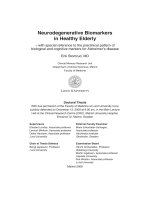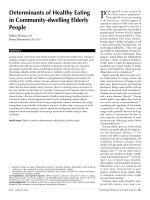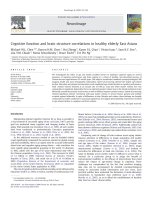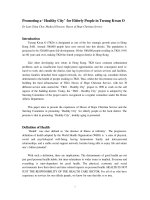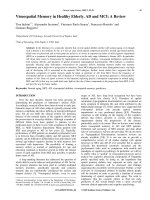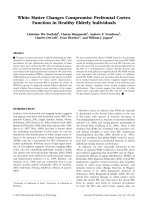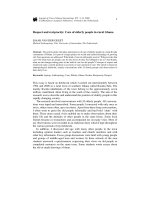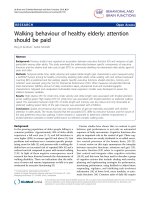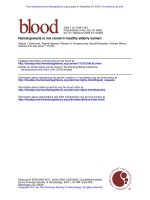FUNCTIONAL EVALUATION DISTINGUISHES MCI PATIENTS FROM HEALTHY ELDERLY PEOPLE - THE ADCS/MCI/ADL SCALE pot
Bạn đang xem bản rút gọn của tài liệu. Xem và tải ngay bản đầy đủ của tài liệu tại đây (191 KB, 7 trang )
Introduction
Due to the progressive aging of the population, there is
increasing concern and interest on age-related disorders, with
the aim of promoting as much autonomy and quality of life as
possible in the elderly.
The concept of activities of daily living (ADL) as an
expression of the functional state was introduced by Katz (1)
and developed by Lawton, who proposed dividing ADL in
basic activities (BADL), such as eating, taking care of the
hygiene, using the bathroom or getting dressed; and
instrumental activities (IADL), more demanding in terms of
cognitive function, such as shopping, handling money, cooking,
housekeeping and using the telephone (2). These abilities of
daily living define how independently people live. They rely on
cognitive functions like memory and attention, but also on
automatic procedures (procedural memory), strengthened by
habits and routines that often guarantee some level of
independence, despite eventual progressive cognitive
impairments (3). More recently, the concept of complex
activities of daily living (CADL) was developed, which
involves superior cognitive functions, translated in activities
like the ability to maintain a job, travel and plan travelling,
participate in groups or community movements, drive, plan
events or play games (4). Functional evaluation is sensitive to
slight changes in cognition, namely memory, attention and
executive functions that may not be easily identified through
routine neuropsychological testing (5) but play an important
role in the early difficulties that patients experience in their real
life context. Thus, even slight changes in cognitive function
may be sufficient to produce gradual loss of CADL and
subsequently IADL (3, 6, 7).
The concept of Mild Cognitive Impairment (MCI) has
evolved in the last decade to characterize a transitional state
between normal cognitive aging and dementia. Patients with
MCI have cognitive complaints and objective impairment in
memory and/or other cognitive domains, without major
repercussions in daily life, and are not demented (8). MCI is a
condition that often progresses to dementia; in particular,
amnestic MCI is frequently an incipient stage of Alzheimer’s
disease (AD) (9). Thus, diagnosis of MCI may lead to an
adequate early intervention allowing patients and families to do
a more appropriate long term planning of their lives (10).
One of the requisites in the original MCI diagnosis criteria is
maintenance of normal activities of daily living (8). According
to a recent revision of these criteria, patients should have no
difficulties with BADL, but can have slight impairments in
IADL and CADL (11). It is presently recognized that keeping
the absence of impairment in all activities of daily living as a
diagnostic criteria would probably be too restrictive, resulting
in an underestimation of the MCI prevalence (3, 12) and
hindering the ability to predict dementia (5). Several studies
have shown a significantly higher frequency of functional
impairment in patients with MCI when compared to the normal
FUNCTIONAL EVALUATION DISTINGUISHES MCI PATIENTS
FROM HEALTHY ELDERLY PEOPLE - THE ADCS/MCI/ADL SCALE
H. PEDROSA
1
, A. DE SA
2
, M. GUERREIRO
1,3
, J. MAROCO
4
, M.R. SIMOES
5
,
D. GALASKO
6
, A. DE MENDONCA
1,7
1. Dementia Clinics, Institute of Molecular Medicine and Faculty of Medicine of Lisbon, Lisbon, Portugal; 2. Neurology Clinics, Hospital of Santo André, Leiria, Portugal; 3. Laboratory
of Language, Institute of Molecular Medicine and Faculty of Medicine of Lisbon, Lisbon, Portugal; 4. Superior Institute of Applied Psychology, Lisbon, Portugal; 5. Psychological
Assessment Service, Faculty of Psychology and Educational Sciences of the University of Coimbra, Coimbra, Portugal; 6. Department of Neurosciences, University of California, San
Diego, US; 7. Laboratory of Neurosciences, Institute of Molecular Medicine and Faculty of Medicine of Lisbon, Lisbon, Portugal. Corresponding author and reprint requests:
Alexandre de Mendonça, Laboratory of Neurosciences, Institute of Molecular Medicine, Av Prof Egas Moniz, 1649-028 Lisbon, Portugal, Telephone 351217985183,
Telefax, 351217999454,
Abstract: Patients with MCI may present minor impairments in activities of daily living (ADL). The main
objective of this work was to evaluate the ability of two versions of the Alzheimer's Disease Cooperative Study /
Activities of Daily Living scale adapted for MCI patients (ADCS/MCI/ADL18 and ADCS/MCI/ADL24) to
distinguish patients with MCI from healthy control subjects. Participants were 60 years or older and community
dwelling: 31 control subjects, 30 aMCI patients and 33 AD patients. A protocol of neuropsychological tests,
global evaluation scales, functional scales, and depressive symptoms assessment was used. Activities of
balancing the cheque book, using a telephone, going shopping, taking medication regularly, finding objects,
talking about current events, watching television, initiating complex activities, keeping appointments or
meetings, reading, getting around outside the home and driving a car were impaired in aMCI patients. The
ADCS/MCI/ADL24 scale was better than the ADCS/MCI/ADL18 scale in distinguishing aMCI patients from
healthy controls (sensitivity=0.87, specificity=0.87, ROC c=0.887, cut-off point=52/53). The detection of initial
functional changes with appropriate scales may contribute to the early diagnosis of MCI and the development of
targeted interventions to improve everyday function or prolong independence.
Key words: Mild Cognitive Impairment, functional evaluation, activities of daily living, ADCS/MCI/ADL,
Alzheimer’s disease.
703
The Journal of Nutrition, Health & Aging©
Volume 14, Number 8, 2010
JNHA: CLINICAL TRIALS AND AGING
Received August 19, 2009
Accepted for publication December 7, 2009
704
The Journal of Nutrition, Health & Aging©
Volume 14, Number 8, 2010
FUNCTIONAL EVALUATION IN MCI
population (3, 5, 6, 13, 14). In the PAQUID project (5), those
patients with MCI who presented impairment in IADL had
greater probability to progress to dementia, and less chances of
going back to normality after 2 years, when compared to
patients with MCI but without functional impairment.
Despite the value of complementing neuropsychological
evaluation with functional measures in MCI patients, there are
still no recommended instruments, reference values or objective
orientations regarding the degree of ADL impairment in this
population (3, 5, 12). In fact, most available instruments were
usually designed to evaluate people with dementia, and are not
sensitive enough to detect changes in patients in the initial
phases of cognitive decline, like MCI patients (10, 11, 14-16).
The development and generalization of new instruments
designed to evaluate daily function in subjects with MCI would
allow a detailed characterization of the ADL changes in these
patients and possibly, when added to the neuropsychological
evaluation, lead to a more accurate diagnosis of the condition.
The Alzheimer's Disease Cooperative Study / Activities of
Daily Living scale for MCI patients (ADCS/MCI/ADL) is a
functional evaluation scale for MCI patients, based on the
information provided by an informant/carer, that describes the
performance of patients in several activities of daily living. It
was adapted by Douglas Galasko and co-workers from the
original ADCS/ADL scale, which was constructed to evaluate
patients with dementia in the Alzheimer’s Disease Cooperative
Study, as a measure of the AD patients’ performance in ADL
(17). The ADCS/MCI/ADL has been used in several studies
and clinical trials to monitor the evolution of patients with MCI
(6, 7, 18, 19). After the development of the ADCS/MCI/ADL
18 items scale, the authors decided to add 6 experimental items,
considered more appropriate to the MCI population – this
version with 24 items will be henceforth referred to as the
ADCS/MCI/ADL24 (and the 18 items version will be further
referred to as the ADCS/MCI/ADL18).
Presently, to our knowledge, only one study determined the
sensitivity and specificity values for the diagnosis of MCI
versus controls, using the shorter version of the scale (7). The
main objective of this work is to compare the ability of both
versions of the scale (ADCS/MCI/ADL18 and
ADCS/MCI/ADL24) in distinguishing patients with MCI from
healthy controls. Other objectives are to evaluate the ability of
the scale to distinguish patients with MCI from patients with
AD, and to characterize the main functional features that
differentiate healthy controls, patients with MCI, and patients
with AD.
Methods
Participants
Participants were patients with MCI and patients with AD
attending two Memory Clinics and a hospital neurology
outpatient clinic. For reasons of sample homogeneity, only
patients with the amnestic type of MCI (aMCI) were recruited.
Control subjects were volunteers, usually spouses or friends of
patients who were requested to participate in the study. The
ADL reports from all groups were collected from an
informant/caregiver who lived with the subject or regularly
spent time with the subject (mostly spouses or sons/daughters).
The study was approved by the local ethics committee. Before
any procedure, the participants gave their informed consent.
To be eligible for the study, all participants had to be 60
years or older and community dwelling. Specific inclusion
criteria for the groups were:
Control group
(1) No evidence for cognitive deterioration or cognitive
complaints;
(2) Mini Mental State Examination (MMSE) above cut-off
(see below);
(3) Immediate free recall of story A from the Logical
Memory (LM) subtest of the Wechsler Memory Scales above
cut-off (see below);
(4) Maintained activities of daily living as evaluated by
normal Lawton Instrumental Activities of Daily Living
(LIADL) scale, that is to say, no item from this scale suffered
any change.
aMCI
Inclusion criteria for aMCI were adapted from the criteria
proposed by the Working Group in MCI of the European
Alzheimer’s Disease Consortium (12, 13):
(1) Cognitive complaints and cognitive decline during the
last year, reported by the patient and/or family;
(2) MMSE above cut-off;
(3) Immediate free recall of story A from the Logical
Memory subtest of the Wechsler Memory Scales at least 1
standard deviation (SD) below the norm for age and education;
(4) Maintained activities of daily living or slight impairment
in instrumental activities of daily living, in other words, no
more than one item from the LIADL scale suffered any changes
(20);
(5) Absence of dementia, according to the DSM IV – TR
criteria (21).
AD
Diagnosis of the AD patients was based on the DSM IV –
TR criteria (21).
Exclusion criteria for all groups:
(1) Presence of other neurological and/or psychiatric
pathologies that could cause cognitive impairment;
(2) History of alcohol or drug abuse;
(3) Symptoms of severe depression, that is, Geriatric
Depression Scale (GDS) > 20.
Of the 108 participants initially evaluated, 14 were excluded
from the study for the following reasons: severe depression
symptoms at time of evaluation (GDS>20), which could be a
confounding variable in the MCI diagnosis (n=2); history of
705
The Journal of Nutrition, Health & Aging©
Volume 14, Number 8, 2010
JNHA: CLINICAL TRIALS AND AGING
stroke (n=7); psychiatric illness (n=1); lack of collaboration
from the caregiver, being in a hurry (n=2); controls with low
performance in neuropsychological tests (n=2).
Procedures
All aMCI and AD cases were subjected to clinical history,
neurological examination, laboratorial evaluation and brain
imaging (CT scan or NMR scan) (22). All participants had the
same evaluation protocol which comprised:
(1) Mini Mental State Examination (MMSE) (23). The
MMSE is widely used for brief evaluation of the mental state
and screening of dementia; the normative cut-off values for the
Portuguese population adjusted to education were used (24).
Subjects had to score above 22 if they had ≤11 years of
education, or above 27 if they had >11 years of education.
These cut-off values adjusted to the education levels were
similar to those found in other studies (25, 26).
(2) Logical Memory subtest from the Wechsler Memory
Scale (WMS) (27), which is included in the Battery of Lisbon
for the Evaluation of Dementia (BLAD) (28). Memory was
considered impaired when the subjects scored on immediate
free recall of story A of the test at least 1 standard deviation
(SD) below the normal for age and education. Although in
other studies performance was considered abnormal when
scores are 1.5 SD below the mean for age and education
matched control subjects, there is no standard cut-off to
implement the memory impairment criteria (11, 29). A cut-off
value of 1 SD was adopted considering that it allows the
identification of subjects with slight cognitive changes but
already fulfilling MCI criteria and at a high risk of developing
dementia; also, the use of the cut-off value of 1.5 SD could
exclude subjects that from a clinical point of view suffered
from MCI (30).
(3) Geriatric Depression Scale (GDS) (31, 32). The GDS is a
self-report assessment used specifically to evaluate depression
in the elderly. The complete version (30 items) was used for
this study.
(4) Clinical Dementia Rating Scale (CDR) (32, 33). The
CDR is a structured-interview protocol that assesses the
cognitive and functional performance in six areas: memory,
orientation, judgment and problem solving, community affairs,
home and hobbies and personal care, in order to quantify the
severity of dementia symptoms.
(5) Blessed Dementia Rating Scale (BDRS) (32, 34). The
BDRS is a brief behavioural scale based on an interview to a
close informant, assessing functional ability for activities of
daily living and changes in personality.
(6) Lawton Instrumental Activities of Daily Living Scale
(LIADL) (2, 32). The LIADL score reflects the number of
impaired activities and ranges from 0 (no impairment) to 8
(changes in all items). Items were classified as not applicable if
the activity had never been done before or if the subject
stopped doing it for reasons other than cognitive difficulty (35).
Activities of daily living were considered preserved if no item
from the LIADL scale suffered any change, or mildly affected
if only one item from the LIADL scale was altered (20).
(7) The Alzheimer's Disease Cooperative Study / Activities
of Daily Living scale for MCI patients (ADCS/MCI/ADL) is a
functional scale based on the information provided by an
informant/caregiver that describes the performance of patients
in several activities of daily living (17). The original version of
ADCS/MCI/ADL comprises 18 items (ADCS/MCI/ADL18,
score of 0 to 53). The version with 24 items
(ADCS/MCI/ADL24, score of 0 to 69) has 6 further items and
is considered more adapted to the MCI population.
Statistical Analysis
Statistical analysis was performed using Statistical Package
for the Social Sciences (SPSS 15.0, SPSS Inc: Chicago, IL). A
significance level = 0.05 was used in all analyses. The
outliers analysis was done taking into account the primary
variable in the study – ADCS/MCI/ADL. No outliers (defined
as values 1.5 times lower than the 1st quartile or 1.5 times
higher than the 3rd quartile) (36) were found in all the groups.
We checked the homogenous distributions of the
demographical variables, namely age and education with
ANOVA one-way and sex with the Chi-square test.
In what regards the functional description of the groups, we
analysed participation frequencies in the tasks/activities defined
in the items of the scale and searched for significant differences
among the groups in each item, using Kruskal-Wallis non-
parametric ANOVA followed by LSD on ranks (36) (the Chi-
square test was used for item 24). This procedure was also used
to search for significant differences in the neuropsychological
evaluation among groups, since the assumption of normal
distribution and homogeneity of variances was not fulfilled in
neuropsychological evaluation tests.
We defined cut-off points for both versions of the scale and
studied the scale sensitivity and specificity values for each cut-
off point. After defining the cut-off point with the best
sensitivity and specificity values, we determined the
discriminant performance of the scale, observing the Receiver
Operating Characteristic curve (ROC) (36) and compared the
Areas Under the Curve (AUC) with the Z test (37) to check for
significant differences between both versions of the scale.
Results
Ninety-four participants (55 women and 39 men) were
included in the study, divided in 3 groups: control (n=31);
aMCI (n=30) and AD (n=33). There were no statistical
differences among the groups regarding the demographical
variables (Table 1).
The three groups scored differently in the
neuropsychological tests, MMSE and Logical Memory, as well
as in global scales, CDR and Blessed Dementia Scale, and in
functional scales, Lawton and ADCS/MCI/ADL (Table 1).
Regarding evaluation of depressive symptoms, there were
significant differences in the GDS scores between the aMCI
and AD, and control and AD groups, but not between the
control and the aMCI groups (Table 1).
FUNCTIONAL EVALUATION IN MCI
The Journal of Nutrition, Health & Aging©
Volume 14, Number 8, 2010
706
Table 1
Demographical variables and results in neuropsychological tests, global evaluation scales, functional scales, and depressive
symptoms in control subjects, patients with aMCI and patients with AD. MMSE, Mini Mental State Examination; LM, Logical
Memory subtest from the Wechsler Memory Scale; CDR, Clinical Dementia Rating Scale; GDS, Geriatric Depression Scale;
BDRS, Blessed Dementia Rating Scale; LIADL, Lawton Instrumental Activities of Daily Living Scale; ADCS/MCI/ADL,
Alzheimer's Disease Cooperative Study / Activities of Daily Living scale adapted for aMCI patients. Significant differences
among the groups were assessed with one-way ANOVA for age and education, the Chi-square for sex, and Kruskal-Wallis non-
parametric ANOVA followed by LSD on ranks for all the other measures. NS = not statistically significant.
Control aMCI AD Statistics p-value Statistical significance
N 31 30 33
Age (years) Mean (SD) 72.2 (8.0) 75.7 (6.4) 76.1 (7.5)
Min 60 60 62 F= 2.826 (2) 0.064 NS
Max 90 91 91
Sex Men 18 10 11 X
2
= 5.23 (2) 0.073 NS
Women 13 20 22
Education (years) 3.3 (1.9) 4.9 (3.1) 3.5 (2.9) F=2.942 (2) 0.058 NS
MMSE 27.7 (3.0) 24.4 (3.3) 16.5 (5.2) X
2
KW
(2) = 53.13 < 0.001 C > MCI > AD
LM 9.3 (2.9) 5.6 (2.5) 1.5 (2.2) X
2
KW
(2) = 56.56 < 0.001 C > MCI > AD
CDR 0.0 (0.0) 0.5 (0.0) 1.6 (0.7) X
2
KW
(2) = 89.41 < 0.001 C < MCI < AD
GDS 6.9 (3.8) 8.6 (4.5) 11.3 (4.7) X
2
KW
(2) = 13.70 < 0.001 C, MCI < AD
BDRS 1.1 (1.4) 3.6 (1.6) 8.8 (4.8) X
2
KW
(2) = 66.32 < 0.001 C < MCI < AD
LIADL 8.0 (0.0) 7.3 (0.5) 2.8 (2.1) X
2
KW
(2) = 45.15 < 0.001 C > MCI > AD
ADCS MCI ADL18 47.0 (4.2) 39.6 (6.3) 17.8 (11.8) X
2
KW
(2) = 66.86 < 0.001 C > MCI > AD
ADCS MCI ADL24 59.3 (6.7) 46.7 (8.3) 20.7 (13.2) X
2
KW
(2) = 69.49 < 0.001 C > MCI > AD
Table 2
Performances in the distinct items of ADCS/MCI/ADL scale in controls, aMCI patients, and AD patients. The mean (SD) scores
are shown. Statistical significance was tested using Kruskal-Wallis non-parametric ANOVA followed by LSD on ranks except for
item 24, where the Chi-square test was used – item 24: percentage of subjects who experienced an extraordinary circumstance that
could influence performance in ADL. NS = not statistically significant
Item Control aMCI AD Statistical significance
1 – finding personal belongings 3.0 (0.2) 2.6 (0.5) 1.5 (0.8) C>MCI>AD
2 – selecting one’s clothes 2.6 (0.9) 2.5 (1.0) 1.4 (1.4) C, MCI > AD
3 – getting dressed 4.0 (0.0) 4.0 (0.2) 2.7 (1.6) C, MCI > AD
4 – cleaning a room 1.2 (0.9) 1.3 (0.9) 0.5 (0.7) C, MCI > AD
5 – balancing the cheque book 1.3 (0.9) 0.9 (0.9) 0.0 (0.2) C>MCI>AD
6 – writing notes 1.0 (0.9) 0.8 (0.8) 0.0 (0.0) C, MCI > AD
7 – doing the laundry 1.1 (1.0) 1.3 (0.9) 0.5 (0.8) C, MCI > AD
8 – keeping appointments 2.8 (0.5) 1.8 (1.0) 0.8 (0.8) C>MCI>AD
9 – using a telephone 3.6 (0.9) 2.7 (2.4) 1.0 (1.1) C>MCI>AD
10 – making a meal or snack 2.7 (0.6) 2.4 (0.9) 0.9 (1.2) C, MCI > AD
11 – travelling out of home 2.8 (0.8) 2.5 (0.9) 0.9 (1.1) C>MCI>AD
12 – talking about current events 3.8 (0.4) 2.7 (1.1) 1.6 (1.5) C>MCI>AD
13 – reading for over 5 minutes 2.4 (1.2) 1.5 (1.2) 0.4 (0.8) C>MCI>AD
14 - watching television 3.0 (0.0) 2.2 (1.0) 1.2 (1.0) C>MCI>AD
15 – shopping 1.8 (0.5) 1.4 (0.7) 0.3 (0.6) C>MCI>AD
16 – being left on one’s own 3.0 (0.2) 2.9 (0.4) 2.1 (1.1) C, MCI > AD
17 – using household appliances 3.9 (0.2) 3.7 (0.8) 1.6 (1.8) C, MCI > AD
18 – practicing hobbies 2.8 (0.8) 2.4 (1.2) 0.8 (1.2) C, MCI > AD
19 – driving a car 1.8 (1.4) 0.6 (1.1) 0.2 (0.7) C > MCI, AD
20 – taking medications 3.8 (0.5) 3.1 (1.1) 1.3 (0.9) C>MCI>AD
21 – carrying through complex activities 2.3 (1.3) 0.9 (1.4) 0.2 (0.8) C > MCI, AD
22 – initiating complex activities 1.7 (1.4) 0.5 (1.1) 0.0 (0.2) C > MCI, AD
23 – time taken to perform complex tasks 2.5 (0.9) 2.2 (0.6) 1.1 (1.0) C>MCI>AD
24 – extraordinary circumstances 23% 13% 3% NS
JNHA: CLINICAL TRIALS AND AGING
The Journal of Nutrition, Health & Aging©
Volume 14, Number 8, 2010
707
Table 3
Capability of the ADCS/MCI/ADL scale (18-item and 24-item versions) to distinguish among controls, aMCI patients and AD
patients. AUC, Area Under the Curve, Receiver Operating Characteristic curve
Version of the scale Groups Mean (SD) Cut-off point Sensitivity Specificity AUC False False
Negatives Positives
ADCS MCI ADL
18
Control 46.6 (5.3)
44/ 45 73% 74% 0.842 26.6% 25.8%
aMCI 39.5 (6.5)
aMCI 39.5 (6.5)
33/ 34 88% 83% 0.956 12.9% 16.6%
AD 17.8 (11.8)
ADCS MCI ADL
24
Control 58.9 (7.7)
52/ 53 87% 87% 0.887 13.3% 12.9%
aMCI 46.7 (8.3)
aMCI 46.7 (8.3)
37/ 38 85% 87% 0.955 15.2% 13.3%
AD 20.7 (13.2)
Figure 1
Frequencies of the participation of controls, aMCI patients and AD patients in the tasks (1 to 22) evaluated by the
ADCS/MCI/ADL scale. See Table 2 for characterization of the specific items of the scale. Item 23 is not shown because it relates
to the speed on performance of complex activities. Item 24 is also not shown because it inquires about exceptional circumstances
that could interfere with the performance of ADL
Figure 2
Receiver Operating Characteristic (ROC) curves for the discrimination between controls and MCI (A) using the
ADCS/MCI/ADL18 (ROC c=0.842) and the ADCS/MCI/ADL24 (ROC c=0.887) were significantly different (z=1.97; p=0.049) -
ADCS/MCI/ADL24 is superior in distinguishing MCI patients from healthy controls. ROC curves for the discrimination between
MCI and AD patients (B) using the ADCS/MCI/ADL18 (ROC c=0.956) and ADCS/MCI/ADL24 (ROC c=0.955) were not
significantly different (z=0.043; p=0.965)
The frequencies in which the three groups participated in the
tasks evaluated by the ADCS/MCI/ADL are shown in Figure 1.
Comparison of the scores in the distinct items of the
ADCS/MCI/ADL scale for the three groups of subjects is
shown in Table 2. Patients with aMCI were impaired relatively
to healthy controls in demanding tasks, whereas they performed
well in more basic tasks, where only AD patients had
difficulties (Table 2).
The capability of the ADCS/MCI/ADL to distinguish among
controls, aMCI patients and AD patients was analysed. The cut-
off points that best discriminate between controls and aMCI
patients, and between aMCI patients and AD patients, for both
ADCS/MCI/ADL18 and ADCS/MCI/ADL24, are shown in
Table 3. Although AUC analysis revealed good discriminant
capacity for both versions of the scale, ADCS/MCI/ADL24
presented higher values for the discrimination between aMCI
patients and healthy controls, with good sensitivity (0.87) and
specificity (0.87) values, and a high discriminant performance
(ROC c=0.887; 95% Confidence Interval ]0.802-0.972[; cut-off
point of 52/53) (Figure 2 and Table 3). The shorter
ADCS/MCI/ADL18 scale version had only moderate
sensitivity (0.73) and specificity (0.74) values, and a lower
discriminant performance (ROC c=0.842; 95% Confidence
Interval ]0.747-0.938[; cut-off point of 45/46), in distinguishing
aMCI patients from healthy controls. The comparison of the
AUC with the Z test (38) revealed the ROC curves for Control
vs. aMCI were significantly different (z=1.97; p=0.049) but not
for the aMCI vs. AD patients (z=0.043; p=0.965). Thus,
ADCS/MCI/ADL24 was superior to ADCS/MCI/ADL18 in
distinguishing aMCI patients from healthy controls, but not
aMCI from AD patients.
Discussion
The detection of subjects in the initial phases of cognitive
decline, as in MCI, may be difficult. Research criteria require
the use of sensitive memory and learning tests, which are not
always available in routine clinical practice. Inquiry about
IADL performance to obtain a total score and to assess the
types of IADL that are impaired could offer a way to
complement mental state testing. The detection of mild
functional disturbances, predominantly involving complex
activities, could allow a better distinction of MCI patients from
healthy elderly people (11). The present study showed that the
ADCS/MCI/ADL24 scale had a high accuracy and was
superior to ADCS/MCI/ADL18 scale in distinguishing aMCI
patients from healthy controls. A previous study presented
sensitivity and specificity values for the ADCS/MCI/ADL18
scale, however, a different scoring system was used, from 0 to
57 (7), instead of 0 to 53, precluding direct comparison with the
present results. The increase in diagnostic efficiency of
ADCS/MCI/ADL24 towards ADCS/MCI/ADL18 can be
explained by the nature of the items introduced in the last part
of the scale, which refer to complex abilities, like driving a car
or organizing the medication, where subtle difficulties may be
revealed in MCI patients. Thus, the ADCS/MCI/ADL24 is a
sensitive and specific instrument to aid in accurately
discriminating aMCI patients from healthy elderly people. In
contrast, regarding the distinction between aMCI and AD
patients, both versions of the scale, ADCS/MCI/ADL24 and
ADCS/MCI/ADL18, performed similarly, since the complex
items introduced in the final part of ADCS/MCI/ADL24 should
be difficult for both aMCI patients and AD patients.
Main functional features differentiate healthy controls,
patients with aMCI, and patients with AD. In general, MCI
subjects have an intermediate performance, between the control
group and the AD group (38). We found a functional decline
from the control group to the aMCI group and from this to the
AD group, both in the total ADCS/MCI/ADL score and in the
number of activities in which all patients participated. This
corroborates previous studies that showed significantly lower
scores in the MCI patients when compared to healthy controls
(7) and in AD patients when compared to MCI patients (19).
Because functional impairment is part of the diagnosis of AD,
and patients with moderate AD (mean MMSE of 16), were
enrolled, we found that the AD group was impaired across a
wide range of IADL activities. There was a clear gradient of
progressive functional decline from controls to aMCI and then
to AD.
It is interesting that decline in daily activities follows a
specific pattern, so that higher order functional abilities tend to
decline first, and basic activities of daily living are affected last.
Among the ADCS/MCI/ADL questions, those that are highly
dependent on memory, planning and sustained attention also
appeared to be the earliest and most severely affected in aMCI
in our study. Recent studies in a Canadian cohort, with
participants over 65 years old, showed this relationship between
loss of specific ADLs and the cognitive status at the beginning
of the functional loss (39), although there might be overlapping
in some activities. Furthermore, the instrumental activities
performed away from home tend to get affected earlier than do
those usually performed at home (3, 39).
The activities that we found to decline in aMCI patients as
compared to healthy controls were controlling the cheque book,
using a telephone, going shopping, taking medications
regularly, finding objects, talking about current events,
watching television, initiating complex activities, keeping
appointments or meetings, reading and carrying through
complex activities. Interestingly, this decline was also found in
previous studies, even when using different scales (10, 40). The
present study also identified the tasks of getting around outside
the home and driving a car as affected in aMCI patients as
compared to controls. The activities in which the MCI patients
begin to show impairment seem to depend on large cognitive
resources, namely memory, psychomotor speed, attention and
executive functions (38), although these patients can still
perform basic activities of daily living just as well as healthy
controls. As the disease progresses, and AD is diagnosed,
FUNCTIONAL EVALUATION IN MCI
The Journal of Nutrition, Health & Aging©
Volume 14, Number 8, 2010
708
patients show significant limitations in most items, and initiate
obvious difficulties in basic ADL, that are not shared either by
controls or by MCI patients.
Several limitations must be recognized in the present study.
The MCI patients that were recruited were of the amnestic type,
and no information was obtained regarding other MCI types.
On the other hand, the characteristics of patients being seen in a
clinical setting may differ from individuals in the community
that fulfil criteria for MCI but did not actively seek clinical
evaluation, and thus the present results may not generalize to
community-based MCI samples.
The detection of initial functional changes with appropriate
scales may contribute to the early diagnosis of MCI, and may
also identify those patients who are at greater risk for further
decline (41). The present study showed that the
ADCS/MCI/ADL24 scale has a high accuracy in distinguishing
aMCI patients from healthy controls. The early detection of
these patients and the recognition of specific difficulties should
allow timely and targeted interventions to improve everyday
function or prolong independence.
Acknowledgements: Supported by grants from F undação Calouste Gulbenkian and
Fundação para a Ciência e Tecnologia. The authors acknowledge the facilities provided by
Memoclínica and Hospital de Santo André, EPE.
References
1. Katz S, Ford AB, Moskowitz RW, Jackson BA, Jaffe MW. The index of ADL: a
standardized measure of biological and psychological function. JAMA 1963; 185:
914-919.
2. Lawton MP, Brody EM. Assessment of older people: Self-maintaining and
instrumental activities of daily living. Gerontologist 1969; 9: 179-186.
3. Nygård L. Instrumental activities of daily living: a stepping-stone towards
Alzheimer's disease diagnosis in subjects with mild cognitive impairment? Acta
Neurol Scand Suppl 2003; 107: 42-46.
4. Albert SM, Tabert MH, Dienstag A, Pelton G, Devanand D. The impact of mild
cognitive impairment on functional abilities in the elderly. Curr Psychiatry Rep 2002;
4: 64–68.
5. Peres K, Chrysostome V, Fabrigoule C, Orgogozo JM, Dartigues JF, Barberger-
Gateau P. Restriction in complex activities of daily living in MCI: impact on
outcome. Neurology 2006; 67: 461-466.
6. Perneczky R, Pohl C, Sorg C, Hartmann J, Komossa K, Alexopoulos P, Wagenpfeil
S, Kurz A. Complex Activities of Daily Living in MCI: Conceptual and Diagnostic
issues. Age Ageing 2006; 35: 240-245.
7. Perneczky R, Pohl C, Sorg C, Hartmann J, Tosic N, Grimmer T, Heitele S, Kurz A.
Impairment of activities of daily living requiring memory or complex reasoning as
part of the MCI syndrome. Int J Geriatr Psychiatry 2006; 21: 158-162.
8. Petersen RC, Smith GE, Waring SC, Ivnik RJ, Tangalos EG, Kokmen E. Mild
Cognitive Impairment: clinical characterization and outcome. Arch Neurol 1999; 56:
303-308.
9. Petersen RC, Doody R, Kurz A, Mohs RC, Morris JC, Rabins PV, Ritchie K, Rossor
M, Thal L, Winblad B. Current concepts in mild cognitive impairment. Arch Neurol
2001; 58: 1985-1992.
10. Cromwell DA, Eagar K, Poulos RG. The performance of instrumental activities of
daily living scale in screening for cognitive impairment in elderly community
residents. J Clin Epidemiol 2003; 56: 131-137.
11. Winblad B, Palmer K, Kivipelto M, Jelic V, Fratiglioni L, Wahlund LO, Nordberg A,
Bäckman L, Albert M, Almkvist O, Arai H, Basun H, Blennow K, de Leon M,
DeCarli C, Erkinjuntti T, Giacobini E, Graff C, Hardy J, Jack C, Jorm A, Ritchie K,
van Duijn C, Visser P, Petersen RC. Mild cognitive impairment: beyond
controversies, towards a consensus. J Intern Med 2004; 256: 240-246.
12. Portet F, Ousset PJ, Visser PJ, Frisoni GB, Nobili F, Scheltens P, Vellas B, Touchon
J; MCI working group of the European Consortium on Alzheimer's Disease (EADC).
MCI in medical practice: a critical review of the concept and new diagnostic
procedure. Report of the Mild Cognitive Impairment Working Group of the EADC. J
Neurol Neurosurg Psychiatry 2006; 77: 714–718.
13. Artero S, Touchon J, Ritchie K. Disability and mild cognitive impairment: a
longitudinal population-based study. Int J Geriatr Psychiatry 2001; 16: 1092-1097.
14. Mariani E, Monastero R, Mecocci P. Mild Cognitive Impairment: a systematic
review. J Alzheimers Dis 2007; 12: 23-35.
15. Luis CA., Loewenstein DA, Acevedo A, Barker WW, Duara R. Mild Cognitive
Impairment: directions for future research. Neurology 2003; 61: 438-444.
16. Petersen RC, Stevens JC, Ganguli M. Practice Parameter: early detection of
dementia: MCI (an evidence based review). Neurology 2001; 56: 1133-1142.
17. Galasko D, Bennett D, Sano M, Ernesto C, Thomas R, Grundman M, Ferris S. An
Inventory to assess activities of daily living for clinical trials in Alzheimer's Disease.
The Alzheimer's disease cooperative study. Alzheimer Dis Assoc Disord 1997;
11(Suppl. 2): 33-39.
18. Grundman M, Petersen RC, Ferris SH, Thomas RG, Aisen PS, Bennett DA, Foster
NL, Jack CR Jr, Galasko DR, Doody R, Kaye J, Sano M, Mohs R, Gauthier S, Kim
HT, Jin S, Schultz AN, Schafer K, Mulnard R, van Dyck CH, Mintzer J, Zamrini EY,
Cahn-Weiner D, Thal LJ; Alzheimer's Disease Cooperative Study. MCI can be
distinguished from AD and Normal Aging for clinical trials. Arch Neurol 2004; 61:
59-66.
19. Li M, Ng TP, Kua EH, Ko SM. Brief informant screening test for MCI and early AD.
Dement Geriatr Cogn Disord 2006; 21: 392-402.
20. Pantoni L, Basile AM, Pracucci G, Asplund K, Bogousslavsky J, Chabriat H,
Erkinjuntti T, Fazekas F, Ferro JM, Hennerici M, O'brien J, Scheltens P, Visser MC,
Wahlund LO, Waldemar G, Wallin A, Inzitari D; on behalf of the Ladis study group.
Impact of age related cerebral white matter changes on the transition to disability—
The Ladis Study: Rationale, design and methodology. Neuroepidemiology 2005; 24:
51–62.
21. American Psychiatric Association. Diagnostic and Statistical Manual of Mental
Disorders. Fourth Edition - text review (DSM IV - TR). Washington, DC: American
Psychiatric Press. 2002.
22. Knopman DS, DeKosky ST, Cummings JL, Chui H, Corey-Bloom J, Relkin N, Small
GW, Miller B, Stevens JC. Practice parameter: Diagnosis of dementia (an evidence-
based review). Neurology 2001; 56: 1143–1153.
23. Folstein MF, Folstein SE, McHugh PR. "Mini-mental state": a practical method for
grading the cognitive state of patients for the clinician. J Psychiatr Res 1975; 12: 189-198.
24. Guerreiro M., Silva AP, Botelho MA. Adaptação à população portuguesa da tradução do
"Mini Mental State Examination" (MMSE) [Adaptation to the Portuguese population of
the "Mini Mental State Examination" (MMSE)]. Rev Port Neurol 1994; 1: 9.
25. Uhlmann RF, Larson EB. Effect of education on the mini-mental state examination
as a screening test for dementia. J Am Geriatr Soc 1991; 39: 876–880.
26. Ostrosky-Solis F, López-Arango G, Ardila A. Sensitivity and specificity of the Mini-
Mental state examination in a Spanish-speaking population. Appl Neuropsychol
2000; 7: 25–31.
27. Wechsler D. Manuel de l’échelle clinique de mémoire. Centre de Psychologie
Appliquée. Paris. 1969.
28. Garcia C. Alzheimer’s disease: Difficulties in clinical diagnosis. PhD Dissertation,
Faculty of Medicine, University of Lisbon, Portugal. 1984.
29. Palmer K., Fratiglioni L, Winblad B. What is mild cognitive impairment? Variations
in definitions and evolution of nondemented persons with cognitive impairment. Acta
Neurol Scand 2003; 179: 14–20.
30. Blanchet S, McCormick L, Belleville S, Gély-Nargeot M-C, Joanette Y. Les troubles
cognitifs légers de la personne âgée: revue critique, Rev Neurol (Paris) 2002; 158: 29-40.
31. Yesavage JA, Brink TL, Rose TL, Lum O, Huang V, Adey M, Leirer VO.
Development and validation of a geriatric depression screening scale: a preliminary
report. J Psychiatr Res 1983; 17: 37-49.
32. De Mendonça A, Guerreiro M. Escalas e Testes na Demência [Scales and Tests in
Dementia] (2nd Ed). Lisbon, Portugal: Grupo de Estudos de Envelhecimento
Cerebral e Demências. 2008.
33. Morris JC. The Clinical Dementia Rating (CDR): current version and scoring rules.
Neurology 1993; 43: 2412-2414.
34. Blessed G, Tomlinson BE, Roth M. The association between quantitative measures
of dementia and senile change in the cerebral gray matter of elderly subjects. Br J
Psychiatry 1968; 114: 797-811.
35. Tabert MH, Albert SM, Borukhova-Milov L, Camacho Y, Pelton G, Liu X, Stern Y,
Devanand DP. Functional deficits in patients with mild cognitive impairment:
prediction of AD. Neurology 2002; 58: 758-764.
36. Maroco J. Análise Estatística com utilização do SPSS [Statistical analysis using
SPSS] (3rd Ed). Lisbon, Portugal: Silabo. 2007.
37. Hanly JA, McNeill BJ. A Method of Comparing the Under Receiver Operating
Characteristic Curves Derived from the same cases. Radiology 1983; 148: 839-843.
38. Tam CW, Lam LC, Chiu HF, Lui VW. Characteristic profiles of IADL in chinese
older persons with MCI. Am J Alzheimers Dis Other Dement 2007; 22: 211-217.
39. Njegovan V, Man-Son-Hing M., Mitchell SL, Molnar FJ. The hierarchy of functional
loss associated with cognitive decline in older persons. J Gerontol A Biol Sci Med
Sci 2001; 56: 638-643.
40. Barberger-Gateau P, Commenges D, Gagnon M, Letenneur L, Sauvel C, Dartigues
JF. Instrumental activities of daily living as a screening tool for cognitive impairment
and dementia in elderly community dwellers. J Am Geriatr Soc 1992; 40: 1129-1134.
41. Barberger-Gateau P, Fabrigoule C, Helmer C, Rouch I, Dartigues JF. Functional
impairment in instrumental activities of daily living: an early clinical sign of
dementia? J Am Geriatr Soc 1999; 47: 456-462.
JNHA: CLINICAL TRIALS AND AGING
The Journal of Nutrition, Health & Aging©
Volume 14, Number 8, 2010
709
